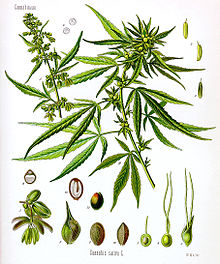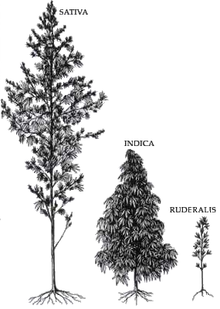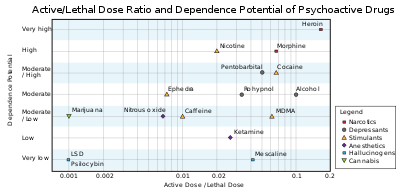大麻属
| 大麻属 | |
|---|---|

| |
| 常见的汉麻 | |
| 科学分类 | |
| 界: | 植物界 Plantae |
| 演化支: | 维管植物 Tracheophyta |
| 演化支: | 被子植物 Angiosperms |
| 演化支: | 真双子叶植物 Eudicots |
| 演化支: | 蔷薇类植物 Rosids |
| 目: | 蔷薇目 Rosales |
| 科: | 大麻科 Cannabaceae |
| 属: | 大麻属 Cannabis L., 1753 |
| 模式种 | |
| 大麻草 Cannabis sativa L., 1753
| |
| 种 | |
|
见正文 | |
大麻属(学名:Cannabis),是蔷薇目大麻科的一属,其该属内的物种,常见说法只列出寻常大麻(Cannabis sativa)一种,也有将印度大麻(Cannabis indica)、莠草大麻(Cannabis ruderalis)也并列为大麻物种的说法[1]。大麻属植物可能起源于中亚或南亚地区,也有研究表明大麻可能源自中国西北部,而不是以前认为的南亚[2]。现今广泛在全球种植,主要生长地区主要包括在亚洲的吉尔吉斯、阿富汗、中国部分地区、印度和尼泊尔以及欧洲的匈牙利、波兰、保加利亚等地。在中国,主要生长于安徽、河南、河北、山西、山东、黑龙江、内蒙古、陕西、甘肃、四川等地。
大麻属植物中存在多种化学物质,被称为大麻素,最明显体现的是四氢大麻酚(THC)和大麻二酚(CBD)两大主要成分,主要存在于大麻的花、叶内,而大麻花穗之中主要成分最多。欧盟根据植株花叶干物质中四氢大麻酚百分含量高低,将大麻分为药用型(THC>0.5%)、中间型(0.3%<THC<0.5% )和纤维型(THC<0.3%)。
分类研究史
[编辑]上级分类
[编辑]在恩格勒系统中,大麻属属于桑科大麻亚科。1925年,Rendl将大麻亚科提升为大麻科,其下包括大麻属和葎草属。在克朗奎斯特分类系统中,大麻属属于荨麻目大麻科,大麻科仍仅有大麻属和葎草属。而依据分子系统发生学建立的被子植物种系发生学组(APG)分类系统,荨麻目之下各科是蔷薇科的近亲,于是合并至蔷薇目,而榆科的七个属根据基因的分析研究,显示这些属与大麻属的关系更近,归入大麻科。大麻科各属的关系如下:
| 大麻科 Cannabaceae |
| ||||||||||||||||||||||||||||||||||||||||||||||||
包含的种
[编辑]
1753年,大麻属(Cannabis)由瑞典植物学家卡尔·林奈建立,林奈在其《Species Plantarum》中仅简单地记载了产于印度的一种大麻(Cannabis sativa L.)。1783年,让-巴蒂斯特·拉马克根据彼埃尔·索纳拉特提供的标本,发表了大麻属的新物种Cannabis indica Lam.,并详细描述了它与Cannabis sativa的不同[3]。
1807年,Persoon将Cannabis indica Lam.降为Cannabis sativa的变种,但未正式发表。直至1911年,Wehmer发表这一组合,即Cannabis sativa var. indica (Lam.) Wehmer。1869年,A·P·德堪多将Cannabis indica Lam.作为Cannabis sativa L.的异名处理,他认为该物种下有Kif、Vulagaris、Pedemontana和Chinensis四个类群,四个类群属于比变种低的等级[3]。
1924年,俄国植物学家德米特里·叶拉斯托维奇·亚尼舍夫斯基调查俄国及俄属地区的大麻后,发表一个新种Cannabis ruderalis Janisch.,他认为该种的显著特征是果实基部有种阜[3]。
1962年彼得·米哈伊洛维奇·茹科夫斯基,1974年理查·舒尔兹等的研究均赞同大麻分为C. sativa、C. indica和C. ruderalis三个种[3]。
1969年,斯莫尔(Small)等人收集50个国家350个产地的大麻果实,在加拿大渥太华栽培,研究后得出大麻属只有大麻(C. sativa L.)一个种,并依据北纬30°和四氢大麻酚为标准将其分为2个亚种:北纬30°以北,THC含量低于0.3%的为C. sativa ssp. sativa;北纬30°以南,THC含量高于0.3%的为C. sativa ssp. indica。每个亚种内又各分出2个变种[3]。
1971年,Fetterman在美国密西西比大学栽培从各地采集的野生大麻和栽培大麻,分析后初步将大麻分为药用型和纤维型[3]。
本属包括以下物种:[4]
植物生理学
[编辑]大麻花是单性的,植物通常是雄性或雌性[5]。
一年生草本,根系发达,梢部有分支;茎梢及中部呈方形,基部为圆形,皮粗糙有沟纹,被短腺毛;掌状复叶,3~13片披针形小叶,边缘有锯齿;花单性,雌雄异株,雄花为白色,花柄细长,圆锥花序;雌花小,无花柄,穗状花序;卵形坚果有棱,深绿色种子。
图片
[编辑]-
植株
-
毛状体
-
叶
-
叶背
-
雄花
-
雌花
-
种子
-
茎与韧皮
野生大麻
[编辑]野生大麻(特别是大麻草)在全世界广泛存在,生长地区包括吉尔吉斯坦、阿富汗、中国部分地带、匈牙利、波兰、保加利亚、印度和尼泊尔。另有印度大麻(Indica)主要生长在阿富汗、美属维尔京群岛和摩洛哥。各地的野生印度大麻基因成分不同。例如在温暖地带,野生印度大麻能长到六米高,但较为寒冷的地方有时候只有30公分高。几乎每朵苞片花都结有种子。野生寻常大麻花苞细长分散,类似圣诞树形状。野生印度大麻则多密集枝条,花苞粗壮,结子较少[6]。在很多地方,野生大麻因为政府清除和城市化,数量受到威胁。
用途
[编辑]大麻 用于各种各样的目的。
历史
[编辑]根据遗传学和考古学证据,在大约 12,000 年前,大麻在早期新石器时代的东亚(新石器时代)期间首次被驯化。[7] 考古学发现在欧亚大陆和非洲的史前社会中记录了大麻作为一种改变意识的药物的使用。[8] 大麻使用作为一种改变思维的药物在欧亚大陆和非洲的史前社会中有考古学发现。[9] 最古老的大麻使用书面记录来自希腊历史学家赫罗多德对中亚斯基泰人以大麻蒸气浴的方式使用的描述。[10] 他(约公元前440年)的作品历史记录说:“正如我所说,斯基泰人取这种大麻籽[可能是花朵],爬在毡帐的下面,把它丢在红热的石头上;它立刻冒烟,散发出希腊蒸气浴无法超越的气味;斯基泰人高兴地欢呼。”[11] 古希腊人和罗马人也使用了大麻。
在中国,大麻的心灵活性特性在神农本草经(公元3世纪)中有描述。[12] 大麻烟被道教信仰者吸入,他们在香炉中燃烧大麻。[12]
在中东,使用蔓延到了伊斯兰帝国和北非。1545年,大麻传入了西半球,西班牙人将其作为纤维进口到智利。在北美,大麻以大麻的形式种植,用于制作绳索、布料和纸张。[13][14][15][16]
在19世纪末,Cannabinol (CBN) 是从大麻提取物中首次分离出来的化合物。在1940年之前,已经确定了其结构和化学合成方法,随后进行了一些首批针对个体大麻衍生化合物效应的动物试验研究。[17]
全球范围内,在2013年,合法生产了60,400公斤的大麻。[18]
娱乐用途
[编辑]

大麻是全球流行的娱乐药物,仅次于酒精、咖啡因和烟草。仅在美国,据信超过1亿美国人尝试过大麻,2500万美国人在过去一年内使用过。[何时?][20] 作为一种药物,它通常以干燥的花序("花蕾"或"大麻")、树脂(哈希什)或各种提取物(统称为大麻油)的形式存在。在20世纪,世界上大部分地区已经将大麻的种植或持有用于销售,甚至有时用于个人用途,定为非法。
大麻的精神活性效应被认为具有三相性质。主要的精神活性效应包括一种放松状态,以及从其主要的精神活性化合物THC中产生的轻微的欣快感。次要的精神活性效应,比如对哲学思考、内省和元认知的能力,在焦虑和偏执症的情况下得到报道。[21] 最后,药物大麻的第三类精神活性效应可能包括心率加快和食欲增加,这被认为是由肝脏中产生的THC代谢物11-OH-THC引起的。
在通过吸烟管、水烟筒或蒸发器吸入较大剂量后,正常认知恢复大约需要三小时。[21] 但是,如果口服大量剂量,效果可能持续更长时间。在24小时至几天后,可能会感到微小的精神活性效应,这取决于剂量、频率和对药物的耐受性。
存在各种大麻的药物形式,包括哈希什和大麻油等提取物,因为外观原因,未经监管时更容易受到掺假剂的影响。
大麻二酚(CBD)本身没有令人陶醉的效果[22](尽管有时会表现出类似于咖啡因的小刺激效果),[23]被认为可以减轻(即降低)[24] 高剂量THC引起的焦虑效应,特别是在THC暴露前口服。[25]
根据英国研究人员在2007年的德尔菲法分析,与尼古丁和酒精相比,大麻的药物依赖风险因子较低。[26] 然而,每天使用大麻可能与心理戒断症状相关,如烦躁或失眠,[21] 并且随着THC代谢物水平升高,患恐慌发作的可能性可能会增加。[27][28][29] 大麻戒断症状通常较轻,并且不会威胁生命。[30] 通过实施以实证为基础的教育和干预工具,并配合实际的监管措施向公众传达,可以降低大麻使用引发的不良后果的风险。[31]
据2014年估计,全球范围内有1.825亿大麻用户(占全球15-64岁人口的3.8%)。[32] 这个比例在1998年到2014年之间没有显着变化。[32]
注释
[编辑]参考文献
[编辑]- ^ 5 Differences Between Sativa and Indica | High Times. 2015-07-16 [2018-11-11]. 原始内容存档于2015-07-16.
- ^ Large-scale whole-genome resequencing unravels the domestication history of Cannabis sativa. [2021-07-18]. (原始内容存档于2021-08-22).
- ^ 3.0 3.1 3.2 3.3 3.4 3.5 杨永红. 大麻属植物分类研究史. 中国麻业科学. 2003, 25 (1): 9–11.
- ^ Cannabis L.. GBIF. [2023-03-31]. (原始内容存档于2023-05-28).
- ^ SHARMA. PLANT TAXONOMY 2E. Tata McGraw-Hill Education. 2011: 459–. ISBN 978-1-259-08137-8.
- ^ Hemp Species. [2006-03-25]. (原始内容存档于2006-10-18).
- ^ Ren G, Zhang X, Li Y, Ridout K, Serrano-Serrano ML, Yang Y, et al. Large-scale whole-genome resequencing unravels the domestication history of Cannabis sativa. Science Advances. July 2021, 7 (29): eabg2286. Bibcode:2021SciA....7.2286R. PMC 8284894
 . PMID 34272249. doi:10.1126/sciadv.abg2286
. PMID 34272249. doi:10.1126/sciadv.abg2286  .
.
- ^ Abel E. Marijuana, The First 12,000 years. New York: Plenum Press. 1980.
- ^ Abel E. Marijuana, The First 12,000 years. New York: Plenum Press. 1980.
- ^ Butrica JL. The Medical Use of Cannabis Among the Greeks and Romans. Journal of Cannabis Therapeutics. June 2002, 2 (2): 51–70. doi:10.1300/j175v02n02_04.
- ^ Herodotus. The History of Herodotus. The Internet Classics Archive. 由Rawlinson G翻译. Daniel C. Stevenson, Web Atomics. 1994–2009 [13 August 2014]. (原始内容存档于29 June 2011).
- ^ 12.0 12.1 Prance G, Nesbitt M, Rudgley R (编). The Cultural History of Plants. Routledge. 2005: 198. ISBN 978-0-415-92746-8.
- ^ Cannabis: History. deamuseum.org. [8 June 2014]. (原始内容存档于17 April 2014).
- ^ Conrad C. Hemp : lifeline to the future : the unexpected answer for our environmental and economic recovery 2nd. Los Angeles, California: Creative Xpressions Publications. 1994. ISBN 978-0-9639754-1-6.
- ^ Herer J. Hemp & the marijuana conspiracy : the emperor wears no clothes New, rev. and updated for 1992. Van Nuys, CA: Hemp Pub. 1992. ISBN 1-878125-00-1.
- ^ Stafford PG. Psychedelics Encyclopedia 3rd expanded. Berkeley, CA: Ronin Publications. 1992. ISBN 978-0-914171-51-5.
- ^ Pertwee, Roger G. Cannabinoid pharmacology: the first 66 years: Cannabinoid pharmacology. British Journal of Pharmacology. 2006, 147 (S1): S163–S171. PMC 1760722
 . PMID 16402100. doi:10.1038/sj.bjp.0706406 (英语).
. PMID 16402100. doi:10.1038/sj.bjp.0706406 (英语).
- ^ Narcotic Drugs 2014 (PDF). International Narcotics Control Board. 2015: 21 [2 June 2015]. ISBN 9789210481571. (原始内容存档 (PDF)于2 June 2015).
- ^ Drug Toxicity. Web.cgu.edu. [17 February 2011]. (原始内容存档于25 March 2008).
- ^ Introduction. NORML. [17 February 2011]. (原始内容存档于11 February 2010).
- ^ 21.0 21.1 21.2 Cannabis. Erowid Cannabis (Marijuana) Vault : Effects. Erowid.org. [17 February 2011]. (原始内容存档于19 August 2016).
- ^ Ahrens J, Demir R, Leuwer M, de la Roche J, Krampfl K, Foadi N, et al. The nonpsychotropic cannabinoid cannabidiol modulates and directly activates alpha-1 and alpha-1-Beta glycine receptor function. Pharmacology. 2009, 83 (4): 217–22 [18 May 2019]. PMID 19204413. S2CID 13508856. doi:10.1159/000201556. (原始内容存档于18 May 2019).
- ^ Block RI, Erwin WJ, Farinpour R, Braverman K. Sedative, stimulant, and other subjective effects of marijuana: relationships to smoking techniques. Pharmacology, Biochemistry, and Behavior. February 1998, 59 (2): 405–412. PMID 9476988. S2CID 29421694. doi:10.1016/S0091-3057(97)00453-X.
- ^ Zuardi AW, Shirakawa I, Finkelfarb E, Karniol IG. Action of cannabidiol on the anxiety and other effects produced by delta 9-THC in normal subjects. Psychopharmacology. 1982, 76 (3): 245–250. PMID 6285406. S2CID 4842545. doi:10.1007/BF00432554.
- ^ Fusar-Poli P, Crippa JA, Bhattacharyya S, Borgwardt SJ, Allen P, Martin-Santos R, et al. Distinct effects of {delta}9-tetrahydrocannabinol and cannabidiol on neural activation during emotional processing. Archives of General Psychiatry. January 2009, 66 (1): 95–105. PMID 19124693. doi:10.1001/archgenpsychiatry.2008.519
 .
.
- ^ Nutt D, King LA, Saulsbury W, Blakemore C. Development of a rational scale to assess the harm of drugs of potential misuse. Lancet. March 2007, 369 (9566): 1047–53. PMID 17382831. S2CID 5903121. doi:10.1016/S0140-6736(07)60464-4.
- ^ Marijuana Detection Times Influenced By Stress, Dieting. NORML. [17 February 2011]. (原始内容存档于20 May 2011).
- ^ Cannabis use and panic disorder. Cannabis.net. [17 February 2011]. (原始内容存档于20 May 2011).
- ^ Lebel-Hardenack S, Grant SR. buy weed online. Geographic. 2011-03-09 [2011-05-17]. (原始内容存档于2023-10-31).
- ^ Myths and Facts About Marijuana. Drugpolicy.org. [17 February 2011]. (原始内容存档于16 February 2011).
- ^ Fischer B, Russell C, Sabioni P, van den Brink W, Le Foll B, Hall W, et al. Lower-Risk Cannabis Use Guidelines: A Comprehensive Update of Evidence and Recommendations. American Journal of Public Health. August 2017, 107 (8): e1–e12. PMC 5508136
 . PMID 28644037. doi:10.2105/AJPH.2017.303818.
. PMID 28644037. doi:10.2105/AJPH.2017.303818.
- ^ 32.0 32.1 United Nations Office on Drugs and Crime. Statistical tables (PDF). World Drug Report 2016. Vienna, Austria. May 2016: xiv, 43 [1 August 2016]. ISBN 978-92-1-057862-2. (原始内容存档 (PDF)于9 August 2016).
外部链接
[编辑]
|
Text is available under the CC BY-SA 4.0 license; additional terms may apply.
Images, videos and audio are available under their respective licenses.








